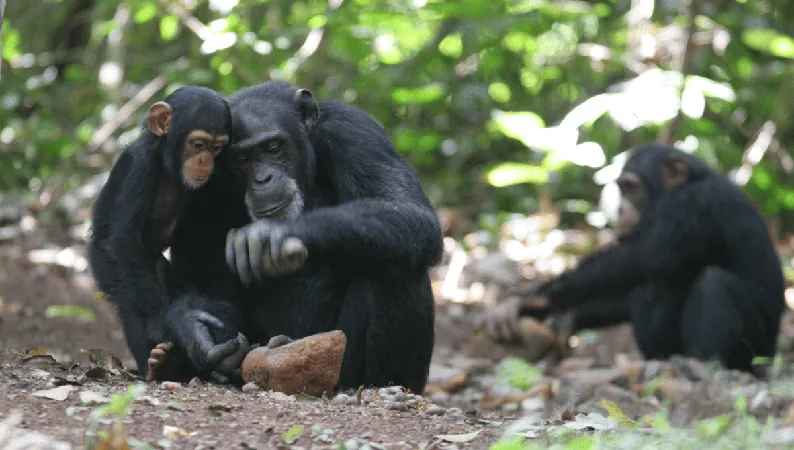
Revolutionary “Genetic Time Machine” Unveils Chimpanzee Culture: A Deep Dive into Cumulative Learning Through Generations
2024-11-25
Author: Siti
In a pioneering study that promises to reshape our understanding of chimpanzee behavior, researchers have uncovered significant evidence that chimpanzee culture is cumulative, evolving over time across different social groups. Utilizing what they term a “genetic time machine,” scientists meticulously traced the gene transfer among chimpanzee populations, revealing how cultural practices, particularly tool use, are not random occurrences but rather shared behaviors that develop over generations.
Chimpanzee culture was initially recognized in the late 1990s, primarily through various instances of tool use, which can vary from simple (like using stones for cracking nuts) to complex (utilizing different tools collaboratively, such as leaves and sticks for catching termites). Understanding how these techniques originate and proliferate within and between groups provides vital insights into our evolutionary relatives’ cognitive capabilities.
Cultural Evolution: How Ideas Spread Among Chimps
The study emphasizes that while certain concepts may independently arise within various chimpanzee communities, they can simultaneously evolve and become more sophisticated as they are shared among group members. This phenomenon of cumulative culture mirrors certain aspects of human cultural development. However, a key distinction exists in flexibility; humans possess a greater capacity to innovate and diverge culturally compared to chimps, whose cultural practices are often constrained by social hierarchies and existing traditions.
Lead researcher Professor Andrew Whiten noted that female chimpanzees play a crucial role in this cultural transmission, often migrating between communities. This not only facilitates genetic diversity but also introduces new cultural practices. However, the challenges they face include adapting to different social structures, as dominant individuals may overshadow newcomers, influencing which behaviors are adopted or observed.
Over the years, notable studies have illustrated instances where tool use—like the unique nut-cracking behavior observed in the Taï National Park of Côte d'Ivoire—endures despite the turnover of community members. This highlights the complex and fragile nature of cultural transmission among these primates.
Revolutionary Methods: The “Genetic Time Machine”
The investigative team leveraged modern genetic techniques to delve deep into the past, examining millennium-spanning genetic history to track cultural evolution. This approach allows researchers to bypass the short-lived nature of physical tools, relying instead on the durable legacy of genetic material. The results convincingly linked cultural practices with the migratory patterns of female chimps, suggesting that cultural knowledge and advanced techniques spread as these females connect with new groups over time.
Implications for Human Evolution and Conservation
As research progresses, findings from chimpanzees are leading scientists to reconsider the origins of culture in our own evolutionary history. Questions arise regarding whether these cumulative cultural traits extend back to our last common ancestor with chimpanzees. Exploring the interconnectivity of migration patterns between both species may shed light on our shared evolutionary pathways and the development of complex cultural traits.
In a remarkable application of their findings, the research has gained attention from the United Nations Environment Programme (UNEP), urging a broader perspective on conservation efforts. It suggests that alongside preserving biodiversity, there is an urgent need to safeguard the cultural diversity of animal species. For example, specific actions have already been initiated to conserve unique cultural practices among chimpanzees in West Africa. These measures highlight the critical importance of local communities and indigenous practices in shaping successful conservation strategies.
The Future of Research and Conservation
Moving forward, the research team aims to deepen their investigations into both chimpanzee and early human cultural evolution, potentially uncovering new insights into the mechanisms of culture as a whole. Understanding how cumulative culture operates not only within chimpanzee communities but also in early human societies could provide transformative insights into our shared history and inform future conservation strategies that respect both ecological and cultural dimensions.
As we unravel the complexities of chimpanzee culture, we move closer to understanding the rich tapestry of life that connects all primates, including ourselves. The pursuit of these revelations promises not only to enhance our scientific knowledge but to inspire more holistic approaches to conservation in the modern world.




 Brasil (PT)
Brasil (PT)
 Canada (EN)
Canada (EN)
 Chile (ES)
Chile (ES)
 España (ES)
España (ES)
 France (FR)
France (FR)
 Hong Kong (EN)
Hong Kong (EN)
 Italia (IT)
Italia (IT)
 日本 (JA)
日本 (JA)
 Magyarország (HU)
Magyarország (HU)
 Norge (NO)
Norge (NO)
 Polska (PL)
Polska (PL)
 Schweiz (DE)
Schweiz (DE)
 Singapore (EN)
Singapore (EN)
 Sverige (SV)
Sverige (SV)
 Suomi (FI)
Suomi (FI)
 Türkiye (TR)
Türkiye (TR)